|
STONE BASINS
WATER PURIFICATION FOUNTAINS
SHINTO AND BUDDHIST TRADITIONS
Chōzubachi 手水鉢 Hand Water Basin
Tsukubai 蹲踞 (つくばい) Stooping Basin
Zenigata Tsukubai 銭型蹲踞
(ぜにがたつくばい)Coin-Shaped Basin
THIS IS A SIDE PAGE
Click Here to Return to “Stones Top Menu”
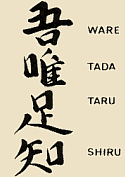 I alone know I am content with things. I alone know I am content with things.
Pronounced “ware tada taru o shiru.” 吾唯足知
This inscription is found often, for reasons unknown to me, on water basins in Japan. This is a Zen saying that can be translated as: "I am content with what I am (have). Rich is the person who is content with what s/he is,” or alternatively, "If you learn to be content, you are rich in spirit!" This inscription is found especially on coin-shaped stone basins (Zenigata Tsukubai 銭型蹲踞) in Japanese tea gardens, perhaps as a reminder to guests to assume a proper state of mental detachment. The tea ceremony itself is an austere, solemn, and simple event associated closely with Zen in Japan. Below are two stone basins inscribed with these four characters.
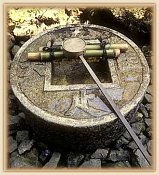
Stone basin inscribed with Ware Tada Taru Shiru

Stone basin inscribed with Ware Tada Taru Shiru
Available online at: shinko-chem.com/exterior/tukubai/tukubai2.htm
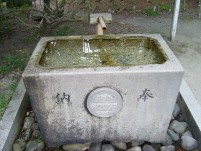 SHINTO TERMINOLOGY SHINTO TERMINOLOGY
JAPAN’S WATER BASINS
Purification by Water (Shinto)
Purification fountains can be found everywhere in modern Japan, including private gardens, homes, and businesses. At all Shinto shrines, worshippers and casual visitors are asked to purify themselves (Harai 祓い) of impurity before praying to the Shinto deities. The act of cleansing is called Misogi 禊 or Misogi Harai 禊祓い, and the actual washing of hands and mouth with water is called Temizu 手水. An associated term is Imi 忌, meaning “abstention from defilement.” Most large shrines have a stone wash basin where worshippers and casual visitors rinse their mouth and hands before approaching the deity (most people no longer rinse their mouth). Sometimes a fire is burning in the shrine compound, and people will waft the smoke over their heads (to catch the blessings of the deity or to burn away their impurities, kanna?). Some Japanese still practice the old tradition of sprinkling water at the gate of their home in the morning and evening to purify the family environs.
- Harai 祓い or Oharai お祓い. Cleansing, Purification.
- Imi 忌. Things to avoid. Impurities. Keeping one's mind & body pure. Abstention from defilement.
- Misogi 禊 & Misogi Harai 禊祓い. Ablutions to remove sin or illness. The act of cleansing.
- Temizu 手水. Washing of Hands, which is often combined with rinsing one’s mouth.
- For a larger and more detailed list, please see Inside the Shrine: Purification.
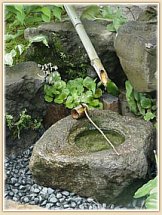 The Misogi (also called Misogi Harai) concept traces its origin to the Kojiki (Record of Ancient Matters). The Kojiki presents numerous tales about Japan’s creation. One is about Izanagi-no-Mikoto, the primordial ancestral kami who purifies himself with water and thereby rids himself of the impurities of the temporal world. The verb form of harai is harau (literally "to brush off dust" or "pay off one's debts." The Misogi (also called Misogi Harai) concept traces its origin to the Kojiki (Record of Ancient Matters). The Kojiki presents numerous tales about Japan’s creation. One is about Izanagi-no-Mikoto, the primordial ancestral kami who purifies himself with water and thereby rids himself of the impurities of the temporal world. The verb form of harai is harau (literally "to brush off dust" or "pay off one's debts."
In Japan, purification ceremonies precede the commencement of all important events and functions. When a new building or home is to be constructed, a groundbreaking ceremony called Jichinsai 地鎮祭 is performed to pacify the earth kami and to purify the spot where construction will take place. New airplanes are purified before their maiden flight. Many car owners take their new vehicles to shrines to be purified with water in a ceremony called Oharai.
Another important concept is Imi, which means “avoidance.” Shinto abhors impurity, and thus all impurity should be avoided -- “imi” is the name given to all things to avoid. In Shinto, the period of mourning following death is also referred to as “imi.” Imikotoba 忌言葉 literally means “words to be avoided.” Imina originally referred to the name of the deceased while still alive, but now it refers to the posthumous name. Misogi Shūhō 禊修法 means to conduct one's own purification ritual by bathing in the sea, the river, or by standing underneath a waterfall cascading at freezing temperatures. For more details on Shinto purification, please visit Inside the Shrine: Purification.
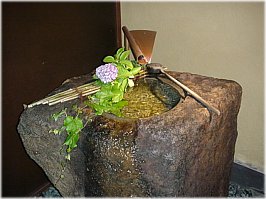
Purification Fountain at Sakahan (Daimon) Sake Brewery
BUDDHIST TERMINOLOGY
JAPAN’S WATER BASINS (MOSTLY ZEN)
Below text courtesy of JAANUS at www.aisf.or.jp/~jaanus/
TSUKUBAI 蹲踞. Literally "stooping basin." A low wash basin used in a tea garden. One has to stoop down to use the basin, hence the name. Before guests enter a tea ceremony room, they must wash their hands and rinse their mouths. The custom was adopted from people washing their hands in streams or purifying themselves at holy washing troughs at shrines before worshipping the gods. A stone with a depression may serve as a wash basin, and a ladle is sometimes provided for the guests use. Sometimes the water is poured into the basin from a bamboo conduit that stops and starts the flow of water depending on the weight of the water flowing into it. A lantern is placed nearby and stones with various roles (yakuishi 役石), are often arranged around the tsukubai. The following are arrangements of stones and wash basins used in tea gardens:
- A wash basin that is arranged in a dry stream or a stream issuing from a pond. This has no trump stones.
- A water basin which has only one stone in front of it (maeishi 前石). This simple arrangement is thought to be the earliest type.
- A wash basin with various stones around it: often the teshokuishi 手燭石 and yuoke ishi 湯桶石 to right and left, the suimon 水門 in the centre and maeishi in front.
- A basin called oritsukubai 降り蹲踞, which is built below ground level, with stone steps leading down to it. Other arrangements include: a tsukubai that is placed either to the left or right side of the entrance to a tea ceremony room facing it; a tsukubai is that placed under a roof provided by a lean-to shelter in front of the entrance; and a tskubai placed in the corner of packed earthen floor in front of the entrance to the tea room. The latter is called uchitsukubai 内蹲踞.
Zenigata 銭形
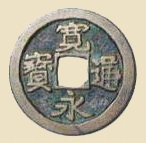 Literally "coin shaped.” A type of coin made during Japan's Edo period, with a square water pool in the middle surrounded by four Japanese characters. This inscription (寛永通宝 Kanei Tsuuhou) was used quite regularly on Edo-period coins, and it simply means "Kanei Era Coin." The Kanei Era (寛永) was from 1623 to 1643 AD. The term 通宝 (also written 通寶) means coin. The inscription was used on coins until about 1860, even though the Kanei era ended in 1643. Literally "coin shaped.” A type of coin made during Japan's Edo period, with a square water pool in the middle surrounded by four Japanese characters. This inscription (寛永通宝 Kanei Tsuuhou) was used quite regularly on Edo-period coins, and it simply means "Kanei Era Coin." The Kanei Era (寛永) was from 1623 to 1643 AD. The term 通宝 (also written 通寶) means coin. The inscription was used on coins until about 1860, even though the Kanei era ended in 1643.
Zenigata Mizubachi 銭形水鉢
Literally coin-shaped water basin. A type of round water basin (chouzubachi 手水鉢) with a square water pool. The flat square in a circle design resembles an old type of Japanese coin or a round handmill. The fusen 布泉 is another type of zenigata mizubachi.
Fusen 布泉
An abbreviation of Fusen no Chouzubachi 布泉の手水鉢. A type of water basin. The best example of the Fusen is found in the tea garden (Roji 露地) of the Sanunshou 山雲 at Kohouan 孤篷庵 of the Daitokuji Temple 大徳寺 in Kyoto. The design is attributed to Kobori Enshu 小堀遠州 (1579-1647). The basin is round, with a square depression for water in the center. The Chinese characters 布 and 泉, pronounced FU and SEN in Japanese, are carved to the left and right of the central water pool. The word fusen refers to copper coins circulated in the Northern Zhou 北周 province of China.
Zenigata Byoubu 銭形屏風
An early type of folding screen (Byoubu 屏風) in which panels are individually made with surrounding borders and hinged together with cords. To prevent the cords from rubbing against the panel surface when it is folded, coin-shaped stoppers, zenigata 銭形, are attached to the borders of each panel. The oldest examples, preserved at the Shousouin 正倉院, date from the Nara period. Each panel was an individual painting type. The composition (often containing several discrete scenes) was usually on silk, mounted with silk brocade borders onto a wood frame and thick paper batting. This screen making technique (and resulting format) is known as oshiebari 押画張 (also written 押絵貼); literally to push on (oshi 押) in order to mount the printing on to the screen panel. The coin-shaped guards are made either of wood or leather and the cords used as hinges are either leather (kawa choutsugai 革蝶番) or braided silk (himo choutsugai 紐蝶番).
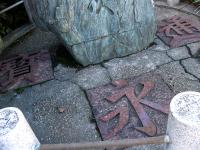 Kanda Myoujin Shrine 神田明神 Kanda Myoujin Shrine 神田明神
Below text courtesy of Dr. Gabi Greve
The Kanda Myoujin Shrine (in current-day Tokyo's Otemachi district) is devoted to Taira no Masakado 平将門, who led a rebellion against the central government during the Heian period. In the Edo period, the shrine's festival was one of the most famous in the city. In modern times, a popular Japanese television series, Zenigata Heiji, features a fictitious police patrolman (the title character) whose beat is in the shrine's vicinity. Near the end of every show, Heiji fells the dastardly villain by throwing a coin at him. Zeni means coin, and Gata means shape or form. If England had Sherlock Holmes. then Japan's answer is Zenigata Heiji. His partner was the comical Hachigoro, a devote but rather unimaginative downtown lad. In the precincts of the Shrine, there is a memorial stone with the following inscription: 寛永通宝 (Kanei Tsuuhou). This inscription was used quite regularly on Edo-period coins, and it simply means "Kanei Era Coin." The Kanei Era (寛永) was from 1623 to 1643 AD. The term 通宝 (also written 通寶) means coin. The inscription was used on coins until about 1860, even though the Kanei era ended in 1643.
LEARN MORE
THIS IS A SIDE PAGE
Click Here to Return to “Stones Top Menu”

|